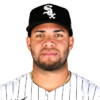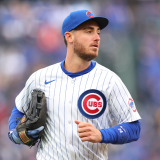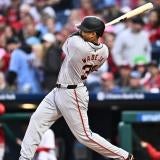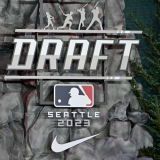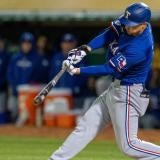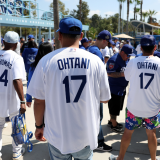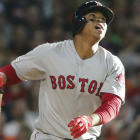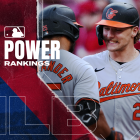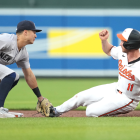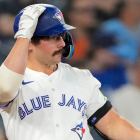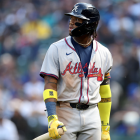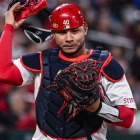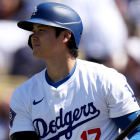For better or worse, we are in the golden age of strikeouts. MLB hitters struck out in 23 percent of all plate appearances in 2019, a new single-season record. In fact, MLB has set a new record high strikeout rate 11 times in the last 12 seasons. Pitchers who rack up strikeouts get paid handsomely (like Gerrit Cole) and hitters who avoid them win MVPs (like Mookie Betts).
Last week we looked at three pitchers who changed roles in 2019. This week we're going to examine three hitters who made huge strikeout rate improvements from 2018 to 2019. Dodgers star Cody Bellinger is not the only player to cut his strikeout rate and see a big performance spike. Here are three hitters who whiffed a lot less and produced a lot more last season.
No player in baseball had more extra-base hits than Red Sox third baseman Rafael Devers in 2019. He swatted 32 homers to go with his league-leading 54 doubles, and he legged out four triples as well. Devers became only the third player with 90 extra-base hits at age 22 or younger in baseball history.
| Year | Age | Doubles | Triples | Home runs | Extra-base hits | |
|---|---|---|---|---|---|---|
Rafael Devers | 2019 | 22 | 54 | 4 | 32 | 90 |
Joe DiMaggio | 1937 | 22 | 35 | 15 | 46 | 96 |
Alex Rodriguez | 1996 | 20 | 54 | 1 | 36 | 91 |
That's some company, huh? Devers paired his extra-base ability with a much lower than average 17.0 percent strikeout rate. In fact, he cut his strikeout rate from 24.7 percent in 2018 to 17.0 percent in 2019, the biggest year-to-year drop in the game among the 136 players with at least 400 plate appearances in each of the last two seasons.
- Rafael Devers: 7.7 percent (24.7 percent to 17.0 percent)
- Cody Bellinger: 7.5 percent (23.9 percent to 16.4 percent)
- Cesar Hernandez: 6.9 percent (21.9 percent to 15.0 percent)
- Wilson Ramos: 6.0 percent (19.2 percent to 13.2 percent)
- Alex Gordon: 6.0 percent (21.8 percent to 15.8 percent)
For Devers, the strikeout rate improvement was the result of experience and maturity, not necessarily an adjustment. He played the entire 2019 season at age 22, remember. Devers was essentially a college senior in the big leagues. He swung at more pitches in the strike zone last year than in 2018, and, with his power, good things will happen when he swings at strikes.
"(He has) bat-to-ball skills that suggest solid batting averages and that, to date, have limited his strikeout totals," wrote Baseball America back in 2017, when they ranked Devers the No. 18 prospect in the game. Early in his MLB career Devers was overly aggressive at the plate, and pitchers were able to exploit that. Now he's better controlling the zone and better driving the pitches he does get to hit. As good as he was in 2019, it feels like Devers is only starting to scratch the surface offensively.
"Overall, offensively, I feel like I'm proud of everything I've been able to do," Devers told MLB.com's Ian Browne last October. "I give a lot of credit to Xander (Bogaerts), who has helped me a lot with my preparation and just everything he's been able to help me with. Just, offensively, I had a really good season and I think I was able to have an overall season that I'm really proud of."
Strikeouts were a significant problem for White Sox infielder Yoan Moncada earlier in his career. In 2017, his debut half-season with the ChiSox, he struck out in 32 percent of his plate appearances. That jumped to 33.4 percent in 2018, the third-highest strikeout rate among qualified hitters. Only Chris Davis (36.8 percent) and Joey Gallo (35.9 percent) struck out more often.
Last season Moncada, who is still only 24, trimmed his strikeout rate to 27.5 percent, the sixth best year-to-year improvement in the game. The added contact turned a league average-ish hitter (98 OPS+ from 2017-18) into an All-Star level hitter (141 OPS+ in 2019) and earned Moncada a $70 million contract extension prior to spring training.
Moncada is a switch-hitter and he improved his strikeout rate from both sides of the plate. As a lefty hitter, he went from a 33.2 percent strikeout rate in 2018 to 26.6 percent in 2019. As a righty, it was 33.9 percent to 29.7 percent. Moncada made more contact as a lefty and that's good, because there are far more right-handed pitchers in baseball than there are lefties.
Weirdly, Moncada's chase rate jumped from 22.2 percent in 2018 -- that was one of the best rates in the league -- to 31.6 percent in 2019, which is more or less league average. Swinging at pitches out of the strike zone is generally no way to cut your strikeout rate, but Moncada made it work, mostly because he made more contact overall. He chases more, but also got the bat on the ball more.
The advanced numbers on Moncada are outrageously good. His 92.8 mph average exit velocity and 47.9 percent hard-hit rate were among the best in baseball last season. When he connects, he makes loud contact. Given his chase rate, Moncada will have to show the improved strikeout rate was real and not a fluke in 2020. His natural talent and athleticism make me a believer.
"I feel very good, very satisfied with having the season I'm having, but at the same time, it's not a fluke," Moncada told NBC Sports Chicago's Vinnie Duber in September. "I'm having the season that I'm having because I worked hard, and I still know that I can do more. I think this season is just a big takeoff for me and a big motivation."
When you think about Marcus Semien improving his game, you think about his defense. The Athletics shortstop was an atrocious defender earlier in his career -- his minus-7 defensive runs saved from 2015-16 made him one of the game's worst shortstops -- but, thanks to hard work, Semien has become a legitimate Gold Glove caliber shortstop. Only Nick Ahmed (plus-47), Paul DeJong (plus-38), and Andrelton Simmons (plus-35) saved more runs at the position than Semien (plus-26) over the last two years.
The bat has started to come around as well. Semien posted a 97 OPS+ from 2014-18, so more than 2,500 plate appearances worth of league-average production, until breaking out with a career high 33 homers and a 138 OPS+ last season. The All-Star level bat and suddenly elite defense made Semien an 8.9 WAR player. He finished third in the AL MVP race.
Semien paired those 33 home runs with a 13.7 percent strikeout rate, the 16th lowest in baseball and equal to noted contact hitters like DJ LeMahieu and Jose Ramirez. Only Yuli Gurriel (10.6 percent), Alex Bregman (12.0 percent), and Anthony Rendon (13.3 percent) slugged 30-plus homers with lower strikeout rates than Semien. Look at this pretty graph:
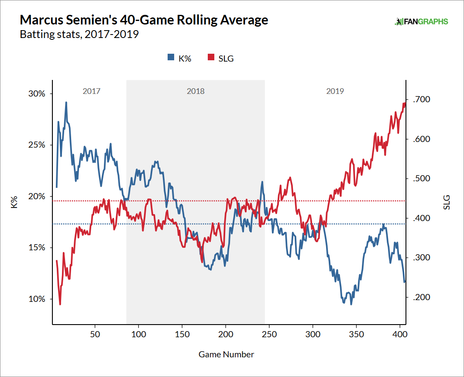
Over the last three seasons Semien's strikeout rate has continued to trend downward while his slugging percentage climbed upward. He's cut his strikeout rate from 22.0 percent in 2017 to 18.6 percent in 2018 to 13.7 percent in 2019. The 4.9 percent year-to-year improvement from 2018-19 was the ninth best in baseball and the third best by a right-handed hitter.
Not coincidentally, Semien's improved strikeout rate comes via improved plate discipline. He's lowered his chase rate from 27.7 percent in 2017 to 24.0 percent in 2018 to 20.9 percent in 2019. Semien was never really a free swinger, but he's become ultra-disciplined. Few hitters chase out of the zone less these days, and when you swing at strikes, good things happen.
"For me, it's plate discipline," Semien told Matt Kawahara of the San Francisco Chronicle in February. "(Last year) I really focused on shrinking the zone and that opened up a lot of things for me. I got into better counts. I learned a lot. My timing was better. Things clicked a lot more. You're still going to have ups and downs, but hopefully those things help me weather the storm, when things aren't going well, to get out of it quicker."
Semien will turn 30 in September and while 2019 was likely a career year -- how could he get better? -- he is poised to enter the free agent market after this season as a Gold Glove caliber shortstop and above-average hitter. He has power, he has very good plate discipline, he doesn't strike out much in an age of strikeouts, and he's a great defender. Financial ramifications of the pandemic aside, Semien is poised to cash in big this winter.









